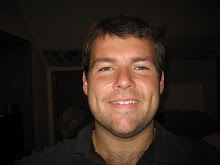My name is Derrick Antoniak, and this is my blog about being a first-year medical student.
At the beginning of the semester, we all received a huge package of nicely three-hole-punched handouts for lecture, lab, and embryology, intended to save us the hassle and money of printing it ourselves (it's literally two three inch binders worth for the first 10 weeks alone). The lectures are each one hour long, so the handouts for a typical single lecture include about six pages of notes, the end of which will say, "The student should be able to:" followed by a list of anywhere from 8 to 12 ridiculously complex learning objectives, each of which has entire textbooks dedicated solely to that subject. Keeping in mind that we have several lectures a day, I thought that was humerous (maybe you had to be there).
Anyways, we were given a surgical demonstration today by a 'surgical oncologist' named Dr. Are. Oncology, if anyone is actually reading this, is a field of medicine dedicated to cancer, so Dr. Are's field is a surgical sub-specialty dealing with the surgical removal of tumors. For the past few years, they have been trying to give students in the first two years exposure to more and more clinical aspects of medicine, and the surgery demonstrations in the anatomy lab are part of that effort. They demonstrated the exact same operation for last year's class, but apparently today was the first chance they had to demonstrate on a so-called 'lightly-embalmed' cadaver. A few interesting notes on the operation: 1) The light embalming process keeps the cadaver feeling much more human, which was an interesting twist on the dissection process. 2) Dr. Are was pointing out landmarks to look for, talking about how they go about finding things, and making sure they don't injure things they don't want to, etc., and it became immensely obvious how important the work we do in the lab really is. The dissection we did today involved two hours of digging through the abdomen in search of maybe 6 or 7 arteries, which could have seemed like a trivial task, until we watched a practicing surgeon open the abdomen and point out each of those arteries in succession (among others), and talk about how important it is to get this one out of the way before you start cutting, and using that one as a landmark for finding this other structure, etc. It was a really nice re-inforcement of what we're doing in there this semester. 3) The operation demonstrated is called the Whipple procedure for resection of pancreatic cancer. When someone is diagnosed with pancreatic cancer, you have to say to them, there is about a five percent chance you'll live five years. But if that person is lucky enough to live close to (or somehow have access to) a place like UNMC, or Johns Hopkins, or one of several other places around the world that does a lot of these kinds of things, that number goes up anywhere from 15-30%. So, for my part, I thought the demo was real fun to watch and a good learning experience.
The other interesting thing is how often cancer comes up this semester. It seems like in all three units so far, we get cancer over and over. I think it has to do with the way they are trying to teach us anatomy. One of the big keys to clinical anatomy is knowing relationships, not just knowing where a structure is, but what lies anterior, posterior, inferior, superior, lateral, medial, what is the blood supply, what is the nerve supply, etc. So cancer really fits into that learning system pretty well. Cancer and trauma. Test questions are always like, "A man gets stabbed with an ice pick in this really specific location", or "A woman with a tumor in this area of wherever", and then ask some question about their deficits, and we have to know all the structures, muscles, arteries, nerves in that area to be able to answer the question. So with cancer and trauma they seem to be able to ask us like 15 questions in one, and, if I had to put my finger on the biggest difference between undergrad anatomy and anatomy here, that would be it.
In other news, I'm going Monday to shadow a surgeon in the sports medicine clinic, and I am pumped. I don't know what I want to specialize in, but if I had to pick today, based on my interests and background, orthopaedic sports medicine would be it, so we'll see over the next couple of months if that's something I really want to pursue. They said once I come into the clinic and see some patients, if there is an operation they schedule that I find interesting, I can say, "I'd like to be there and see that operation". So we'll see.
Thursday, October 9, 2008
Subscribe to:
Post Comments (Atom)

No comments:
Post a Comment